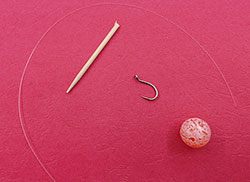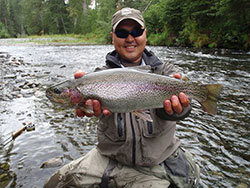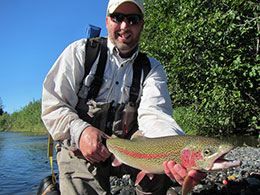Alaska Fish & Wildlife News
September 2013
Fishing Alaska Trout & Char with Beads

Late summer in Alaska has all of my angling buddies and I excited for the pursuit of trophy size wild rainbow trout and char. We are anxious to get our beads out during the peak of the salmon spawn with high hopes for catching some enormous size trout. Fishing beads with a fly rod is not something new. Beads have been and continue to be a very popular method among many experienced trout fisherman and professional guides in Alaska because it is incredibly effective. The technique of “pegging” a bead is easy to learn and simple to employ, however there are a few important aspects anglers new to this method of fishing should be familiar with in order to make best use of this system of fishing. This article is intended to introduce anglers who are unfamiliar with bead fishing and will focus on the basics in order to get an angler started on their way to using this efficient system of fishing and increasing their catch rates of beautiful wild trout in Alaska.
Bead 101
Local resident species of trout can be found in many of Alaska’s fresh water rivers, streams, and creeks which have pacific salmon migrating to spawn. These native fish are eagerly following the salmon and gorging themselves on deposited salmon eggs and rotting fish flesh floating in the current or along the bottom of the streambed. Beads simply imitate drifting salmon eggs.
Beads are not a fly by definition in Alaska fishing regulation; they are considered and defined as attractors. Make sure you check ADF&G regulations prior to using beads, especially in fly fishing only waters. Although they are not considered to be flies, just like traditional flies used in fly fishing, the angler is attempting to match the hatch by using a small colored sphere shaped object with a hole through the middle of it for "pegging" to a line, which replicates a salmon egg traveling downstream.
Beads come in numerous sizes and countless colors in order to represent the various types of eggs from the different salmon species and mimic particular phases the eggs have reached. It can be difficult to wade through all the choices and selections. Several companies specialize in manufacturing trout beads and items can easily be located and purchased ready to use from various local sources in Alaska or from the Internet. Some DIY bead fishermen acquire their beads from hobby or craft stores and custom paint them and applying different colors and shades of nail polish to achieve a desired effect. I personally really like the pre-packaged assorted bead kits that Alaska Fly Fishing Goods has to offer, you get a good selection of colors and sizes and eliminates a lot of the guess work. I picked up a kit for rainbow trout and another for steelhead and have used them with great success.

Bead Size & Color
Bead sizes I typically use for trout range in sizes of 6mm, 8mm, and 10mm. Size considerations include what type of salmon are present spawning, and flow speed of the water. Sockeye (Red) salmon eggs are about equal in size to a 6mm bead, Pinks and Silver salmon eggs get slightly larger at about 8mm, and the largest eggs are from the Chum and King salmon similar in size to approximately a 10mm bead. Water speed will also affect the size best to use. Slower current allows for a smaller bead to be presented and allows a target to be picked up easier by a fish. Swift running channels will have the target drifting much faster and be more difficult for a fish to sight in on, thus a larger bead will be more prudent to use.
Bead color selection is closely tied to what eggs look like which are present when you’re fishing. Before I even cast a line, I survey the slack water areas for any signs of salmon eggs and do my best at matching the color pattern of the eggs already present in the water. Salmon eggs tend to be brighter when freshly deposited and get lighter in color as the stay in the water longer, turning mottled with uneven color tones, eventually fading turning a more solid in tone and color. If I can’t find any salmon eggs to match, I start fishing by using orange mottled or pink mottled tones of colored beads, which closely match fresher deposited eggs. If it’s late in the spawn I go with more faded solid colors. My preferred colors are tangerine and peach in mottled patterns, however carrying a good selection is best choice.
Pegging a Bead
Rigging a bead, or “pegging” a bead, for dead drifting is fairly simple. Although there are a couple different techniques you can use when fixing a bead to the line, I will be keeping things simple and basic procedure I normally use. I like using a 10lb test fluorocarbon leader of between seven and nine feet in length. I begin by threading the selected bead on the leader running end and sliding it on the line. The next step is attaching an appropriate hook; I use short shank hooks in sizes 4, 6, and 8 matching the bead size and I prefer using an improved clinch knot. Once the hook is secured to the end of the line, slide the bead into a position about two inches just above the hook. Insert the tapered end of a toothpick into the bead hole, pushing in on the toothpick and wedge the line between the toothpick and bead hole, this will secure the toothpick like a “peg” in the hole of the bead and lock the bead into a fixed position on the line. The final step is cutting the excess remaining toothpick outside the bead hole with a clipper so it appears flush.

Some companies have developed plastic pegging material which substitutes for a toothpick. It does have certain advantages by being less abrasive on the leader and can also be colored to match the bead color. Carrying a few split shot may come in handy also, as small sized split shot may be added as needed to the leader assisting the bead to sink in the water column and provide a good drift in deeper holes. The use of an indicator on the line can also be useful, however not necessary.
The concept for fishing the bead is to cast it upstream at about a 45 degree angle from your target area, and mend the line to allow the bead to dead drift naturally in the current (very similar to executing a nymphing technique). Be patient and make sure to run the bead more than a few times over your target area. The fish will strike hard and fast. Try to avoid letting the current put drag on the line, or swinging the line like a pendulum, and allow the current to “dead drift” your bead as naturally as possible. Changing the color and size of your bead may improve fishing also.
Practice makes Perfect
Learning to bead fish will take some effort and practice. Bead fishing season in small streams and creeks for me will last through the fall and into late November. There is plenty of time to learn this technique and be fairly successful after only a couple outings. You will see with time vested in this method your catch rate will significantly increase.
An additional benefit of pegging a bead is how seldom hooks are swallowed by the trout. Hooks tend to set just on the outside of the corner of the mouth, and practicing selective harvest or catch & release is done with far less stress to the fish. Make sure you pinch down your barbs if you’re not planning on harvesting or if you’re fishing a catch & release only area.
Guest author Dennis Musgraves spends over 100 days annually sport fishing all over Alaska. Chronicles of his year round Alaskan fishing adventures can be found on a recreational website, which was founded to educate, inspire, and celebrate sport fishing in the Great Land. You can find him at www.alaskansalmonslayers.com
Subscribe to be notified about new issues
Receive a monthly notice about new issues and articles.
